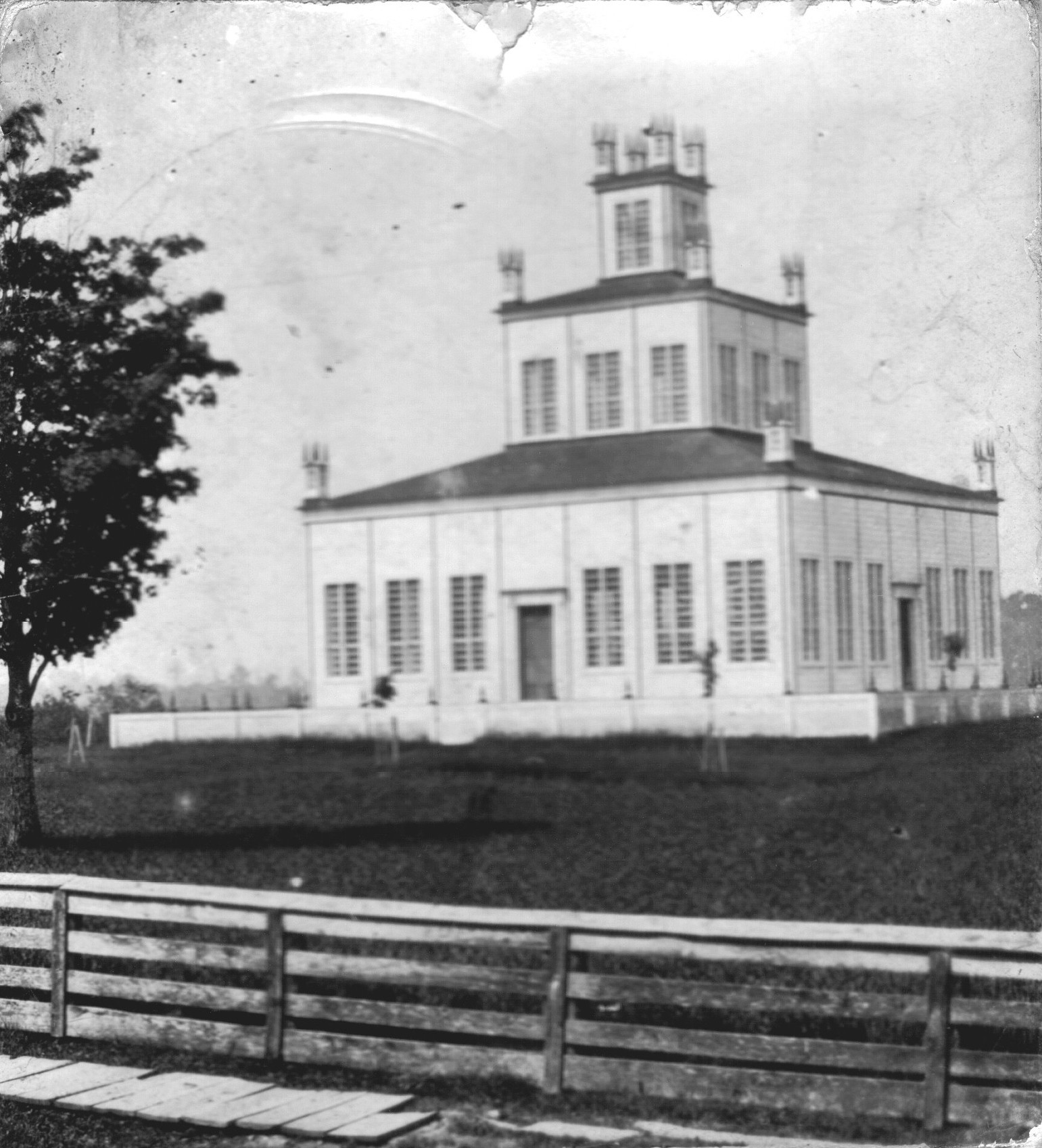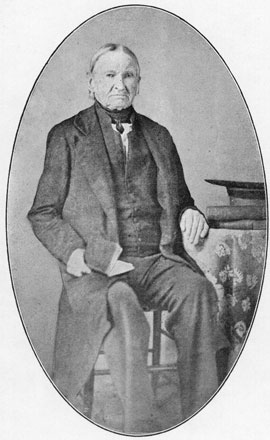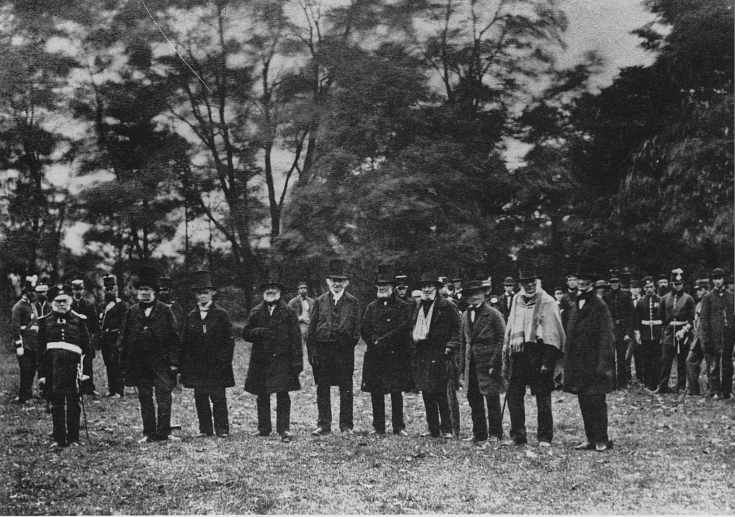|
William Warren Baldwin
William Warren Baldwin (April 25, 1775 – January 8, 1844) was a doctor, businessman, lawyer, judge, architect and reform politician in Upper Canada. He, and his son Robert Baldwin, are recognized for having introduced the concept of "responsible government", the principle of cabinet rule on which Canadian democracy is based. Early life William Warren Baldwin was born in County Cork, Ireland in 1775 of Robert Baldwin Sr. William graduated from the medical school at the University of Edinburgh in 1797. Faced with the prospect of the uprising of the Society of United Irishmen in 1798, he came to Upper Canada with his father and family, arriving in July 1799. The family moved to Durham County, where he became a lieutenant-colonel in the Durham militia and a justice of the peace in 1800. William found few patients in Durham, so he moved to the town of York (Toronto) and took up other occupations. In 1803, he was admitted to the bar and, in 1809, he became a district court judg ... [...More Info...] [...Related Items...] OR: [Wikipedia] [Google] [Baidu] |
List Of Treasurers Of The Law Society Of Upper Canada
The following individuals have held the position of Treasurer of the Law Society of Ontario, Treasurer of the Law Society of Upper Canada (1797–2018) or the Law Society of Ontario (2018–present). Treasurers of the Law Society of Upper Canada (1797–2018) *John White (Frontenac County), John White 1797–1798 *Robert Isaac Dey Gray 1798–1801 *Angus Macdonell 1801–1805 *Thomas Scott (Canadian judge), Thomas Scott 1805–1806 *G. D'Arcy Boulton 1806–1811 *William Warren Baldwin 1811–1815 *G. D'Arcy Boulton 1815–1818 *Sir John Robinson, 1st Baronet, of Toronto 1818–1819 *Henry John Boulton 1819–1820 *William Warren Baldwin 1820–1821 *Sir John Robinson, 1st Baronet, of Toronto 1821–1822 *Henry John Boulton 1822–1824 *William Warren Baldwin 1824–1828 *Sir John Robinson, 1st Baronet, of Toronto 1828–1829 *George Ridout 1829–1832 *William Warren Baldwin 1832–1836 *Robert Baldwin Sullivan 1836 *Robert Sympson Jameson 1836–1841 *Levius Peters Sherwood 1 ... [...More Info...] [...Related Items...] OR: [Wikipedia] [Google] [Baidu] |
Simcoe County, Ontario
Simcoe County is located in the Central Ontario, central portion of Southern Ontario, Canada. The county is just north of the Greater Toronto Area, stretching from the shores of Lake Simcoe in the east to Georgian Bay in the west. Simcoe County forms part of the Greater Golden Horseshoe area, a densely populated and industrialized region, centred on the Greater Toronto Area. The land area of the county is . The elevated Niagara Escarpment runs through sections of the western part of the county, and the Minesing Wetlands, a Ramsar Convention wetland of international importance, is located in the central area of the county. The county administrative centre is on Ontario Highway 26, Highway 26 in Midhurst, Ontario, Midhurst, outside Barrie. Geography Simcoe County is informally split into two subregions, “South Simcoe” and “North Simcoe”. The dividing line between these two areas is Simcoe County Road 90 (Mill St.). South Simcoe municipalities are situated at the northern ... [...More Info...] [...Related Items...] OR: [Wikipedia] [Google] [Baidu] |
The Children Of Peace
The Children of Peace (1812–1889) was an Upper Canada, Upper Canadian Quaker sect under the leadership of David Willson (1778–1866), David Willson, known also as 'Davidites', who separated during the War of 1812 from the Yonge Street Monthly Meeting in what is now Newmarket, Ontario, and moved to the Willsons' farm. Their last service was held in the Sharon Temple in 1889. Between 1825 and 1832, a series of buildings was constructed on the farm, the most notable of which is the Sharon Temple, an architectural symbol of their vision of a society based on the values of peace, equality and social justice, which is now part of an open-air museum that was in 1990 designated as National Historic Site of Canada. They were a "testimony of simplicity, plain folk", former Quakers with no musical tradition, who went on to create the first silver band in Canada and build the first organ in Ontario. They built an ornate temple to raise money for the poor, and built the province's first s ... [...More Info...] [...Related Items...] OR: [Wikipedia] [Google] [Baidu] |
Orange Order In Canada
The Grand Orange Lodge of British America, more commonly known as the Grand Orange Lodge of Canada or simply Orange Order in Canada, is the Canadian branch of the Orange Order, a Protestant fraternal organization that began in County Armagh in Ireland in 1795. It has played a large part in the history of Canada, with many prominent members including four Prime Ministers, among them Sir John A. Macdonald and John Diefenbaker. Upper Canada and the Province of Canada The Orange Lodges have existed in Canada at least since the War of 1812. The first Lodge was established in Montreal by William Burton, Arthur Hopper, John Dyer, Francis Abbott and several others. William Burton travelled to Ireland to obtain the warrant to open the Lodge from the Grand Lodge of Ireland and became the first Grand Master of the Montreal Lodge. In the following years Arthur Hopper was elected the next Grand Master and given the power of granting warrants to subordinate Lodges under the Great Seal of th ... [...More Info...] [...Related Items...] OR: [Wikipedia] [Google] [Baidu] |
William Botsford Jarvis
William Botsford Jarvis (May 4, 1799 – July 26, 1864) was an important member of the Family Compact and Sheriff of the Home District. His estate in what was then York, Upper Canada, gave its name to Rosedale, Toronto. Jarvis Street was named for his cousin, Samuel. Birth Born in Fredericton, New Brunswick, he was the son of United Empire Loyalists from Danbury, Connecticut and named for his father's friend, William Botsford. His father, Lt-Colonel Stephen Jarvis (1756–1840) of the 17th Regiment of Light Dragoons, became Adjutant-General to the Forces in Upper Canada and Gentleman Usher of the Black Rod to the Parliament of Canada. Colonel Jarvis had fought with the British during the American Revolutionary War, but was captured by the Americans in his home town at Connecticut. He escaped in a canoe to Long Island, rejoining the British forces there. After the war he joined some cousins in New Brunswick, where William was born, before being persuaded to move to York, Upp ... [...More Info...] [...Related Items...] OR: [Wikipedia] [Google] [Baidu] |
John Lambton, 1st Earl Of Durham
John George Lambton, 1st Earl of Durham, (12 April 1792 – 28 July 1840), also known as "Radical Jack" and commonly referred to in Canadian history texts simply as Lord Durham, was a British Whig statesman, colonial administrator, Governor General and high commissioner of British North America. A leading reformer, Durham played a major role in the passage of the Reform Bill of 1832. He later served as ambassador to Russia. He was a founding member and chairman of the New Zealand Company that played a key role in the colonisation of New Zealand. George Woodcock says that he was, "Proud, wayward, immensely rich, with romantic good looks and an explosive temper." He was one of those "natural rebels who turn their rebellious energies to constructive purposes. Both at home and abroad he became a powerful exponent of the early nineteenth-century liberal spirit." Background and education Lambton was born 12 April 1792 in the house of his father William Henry Lambton at 14 Berkeley ... [...More Info...] [...Related Items...] OR: [Wikipedia] [Google] [Baidu] |
Upper Canada Rebellion
The Upper Canada Rebellion was an insurrection against the oligarchic government of the British colony of Upper Canada (present-day Ontario) in December 1837. While public grievances had existed for years, it was the rebellion in Lower Canada (present-day Quebec), which started the previous month, that emboldened rebels in Upper Canada to revolt. The Upper Canada Rebellion was largely defeated shortly after it began, although resistance lingered until 1838. While it shrank, it became more violent, mainly through the support of the Hunters' Lodges, a secret United States-based militia that emerged around the Great Lakes, and launched the Patriot War in 1838. Some historians suggest that although they were not directly successful or large, the rebellions in 1837 should be viewed in the wider context of the late-18th- and early-19th-century Atlantic Revolutions including the American Revolutionary War in 1776, the French Revolution of 1789–99, the Haitian Revolution of 1791–18 ... [...More Info...] [...Related Items...] OR: [Wikipedia] [Google] [Baidu] |
Francis Bond Head
Sir Francis Bond Head, 1st Baronet KCH PC (1 January 1793 – 20 July 1875), known as "Galloping Head", was Lieutenant-Governor of Upper Canada during the rebellion of 1837. Biography Head was an officer in the corps of Royal Engineers of the British Army from 1811 to 1825; as such he earned a Waterloo Medal. Afterwards, he attempted to set up a mining company in Argentina. He married Julia Valenza Somerville in 1816, and they eventually had four children. Head was born to parents, James Roper Mendes Head and Frances Anne Burgess. He was descended from the Spanish Jew Fernando Mendes, who accompanied as her personal physician Catherine of Braganza in 1662 when she came to England to marry Charles II. His grandfather Moses Mendes married Anna Gabriella Head and took on the Head name following the death of his wife's father, Sir Francis Head, 4th Bt. In 1834, Head was appointed as an assistant Poor Law Commissioner in Kent. While serving in this capacity, he drew up a docume ... [...More Info...] [...Related Items...] OR: [Wikipedia] [Google] [Baidu] |
The Reform Movement (Upper Canada)
The Reform movement in Upper Canada was a political movement in British North America in the mid-19th century. It started as a rudimentary grouping of loose coalitions that formed around contentious issues. Support was gained in Parliament through petitions meant to sway MPs. However, ''organized'' Reform activity emerged in the 1830s when Reformers, like Robert Randal, Jesse Ketchum, Peter Perry, Marshall Spring Bidwell, and Dr. William Warren Baldwin, began to emulate the organizational forms of the British Reform Movement and organized Political Unions under the leadership of William Lyon Mackenzie. The British Political Unions had successfully petitioned for the Great Reform Act of 1832 that eliminated much political corruption in the English Parliamentary system. Those who adopted these new forms of public mobilization for democratic reform in Upper Canada were inspired by the more radical Owenite Socialists who led the British Chartist and Mechanics Institute movements ... [...More Info...] [...Related Items...] OR: [Wikipedia] [Google] [Baidu] |
John Rolph (politician)
John Rolph (4 March 1793 – 19 October 1870) was a Canadian physician, lawyer, and political figure. He was elected to the Parliament of Upper Canada in 1824 to represent Middlesex County and was considered the leader of the Reform faction in the 1820s. In 1837 he helped plan the Upper Canada Rebellion, but acted as the government's emissary to negotiate a truce once the rebellion began. In the 1850s he was elected to the newly-formed Parliament of the Province of Canada, representing Norfolk County, and was appointed as Minister of Crown Lands and Minister of Agriculture. He founded several medical schools throughout his life, including the Rolph School, and incorporated new teaching techniques and medical practices into his lectures. His actions against rival medical schools decreased public confidence in the ability of medical professionals to regulate themselves. Rolph grew up in Thornbury, Gloucestershire, and was educated in medicine and law at St John's ... [...More Info...] [...Related Items...] OR: [Wikipedia] [Google] [Baidu] |
Cholera Epidemic Of 1831
Cholera is an infection of the small intestine by some strains of the bacterium ''Vibrio cholerae''. Symptoms may range from none, to mild, to severe. The classic symptom is large amounts of watery diarrhea that lasts a few days. Vomiting and muscle cramps may also occur. Diarrhea can be so severe that it leads within hours to severe dehydration and electrolyte imbalance. This may result in sunken eyes, cold skin, decreased skin elasticity, and wrinkling of the hands and feet. Dehydration can cause the skin to turn bluish. Symptoms start two hours to five days after exposure. Cholera is caused by a number of types of ''Vibrio cholerae'', with some types producing more severe disease than others. It is spread mostly by unsafe water and unsafe food that has been contaminated with human feces containing the bacteria. Undercooked shellfish is a common source. Humans are the only known host for the bacteria. Risk factors for the disease include poor sanitation, not enough cle ... [...More Info...] [...Related Items...] OR: [Wikipedia] [Google] [Baidu] |




.jpg)


_(22296408596).jpg)
